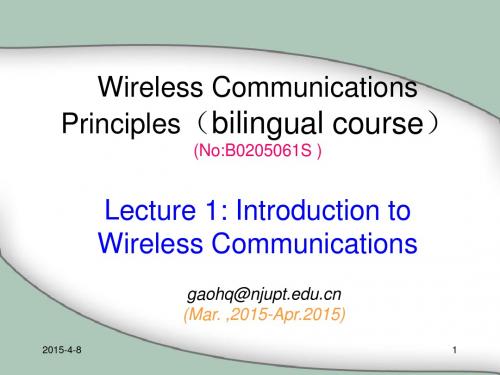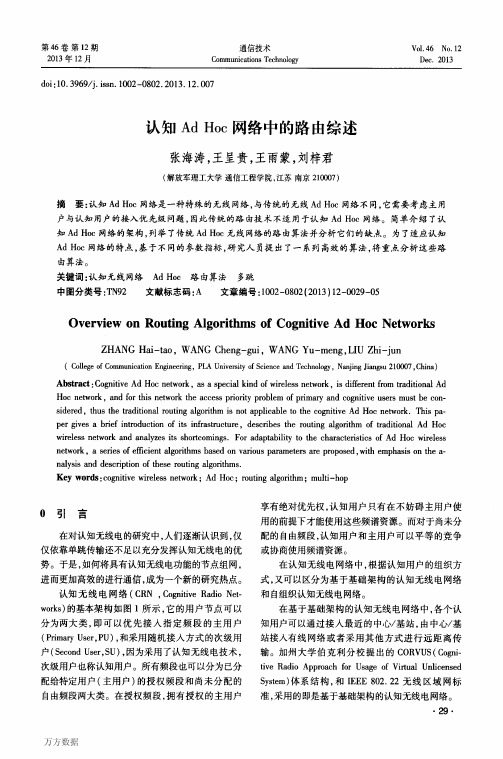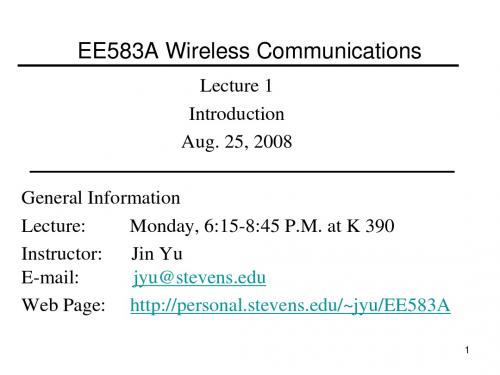LCTURE-1-Introduction-Mobile Ad-hoc Networks (manets)
- 格式:ppt
- 大小:1.79 MB
- 文档页数:28


AN EV ALUATION OF MULTIPLE PATH ROUTING AND ITS IMPACT ON QUALITY OF SER VICE IN MOBILE AD HOC NETWORKSbyGregory B.GerouREMOVEiA thesis submitted to the Faculty and the Board of Trustees of the Colorado School of Mines in partial fulfillment of the requirements for the degree of Master of Science(Mathematical and Computer Sciences).Golden,ColoradoDateGregory B.GerouApproved:ABSTRACTThe topic of multi-path routing protocols has been investigated previously;how-ever,the effectiveness of multi-path routing to improve quality of service by maximiz-ing bandwidth availability,as well as the criteria for determining multi-path routes, have not been clear.For that reason,we have developed a Proactive Disjoint Multi-path Routing protocol(PDMR)that we use to compare single-path routing versus multi-path routing.The results of this investigation illustrate the performance of multi-path routes and their impact on quality of service in a variety of mobile ad hoc network scenarios.iiiTABLE OF CONTENTSABSTRACT (iii)LIST OF FIGURES (vi)LIST OF TABLES (viii)ACKNOWLEDGEMENTS (ix)Chapter1INTRODUCTION (1)Chapter2RELATED WORK (5)2.1MANET Multi-path Routing Protocols (7)2.1.1Diffusing Algorithm for Shortest Multi-path(DASM) (8)2.1.2Disjoint Pathset Selection Protocol(DPSP) (9)2.1.3Multi-path Dynamic Source Routing(MDSR) (11)2.1.4The Graph Multi-path Routing Protocol(GMR) (13)2.1.5The Split Multi-path Routing Protocol(SMR) (15)2.2MANET QoS Frameworks (16)2.2.1Core-Extraction Distributed Ad Hoc Routing(CEDAR) (16)2.2.2Insignia (19)2.2.3Stateless Wireless Ad Hoc Networks(SWAN) (19)Chapter3DISJOINT PATH CLASSIFICATION (21)Chapter4PDMR (26)4.1Network Topology Dissemination (27)4.2Multi-path Discovery Algorithm (28)4.3Multi-path Use Policies (31)4.4The Role of SWAN (32)Chapter5SIMULATION RESULTS (33)5.1Environment (33)5.2Static Network Models (37)5.3Mobile Network Models (46)5.4Contrived Network Model (53)ivChapter6CONCLUSIONS AND FUTURE WORK (58)6.1Conclusions (59)6.2Future Work (60)REFERENCES (63)vLIST OF FIGURES2.1DASM’s path classification example (10)2.2MDSR-Protocol1example (13)2.3MDSR-Protocol2example (13)2.4A comparison of GMR and MDSR (15)2.5CEDAR example network (18)3.1Node disjoint route with two paths (22)3.2Strict link disjoint route with two paths (23)3.3Loose link disjoint route with two paths (23)3.4Semi-node disjoint route with two paths of equal length (24)3.5Semi-node disjoint route with two paths of different length (24)3.6Disjoint route classification hierarchy (25)5.1Route frequencies for various network types(including Route Not Founderror frequencies)as the number of nodes in the network increases..38 5.2Route frequencies for various network types(without Route Not Founderror frequencies)as the number of nodes in the network increases..39 5.3Average route lengths for networks simulated within a region of300mx600m,as the number of nodes in the network increases (40)5.4The average difference between the two paths included in each multi-path route,as the number of nodes in the network increases (42)5.5Total delivery rate for a static network with seven concurrent QoStraffic sessions as the number of simultaneous best effort traffic sessionsvaries (43)5.6Best effort delivery rate for a static network with seven concurrent QoStraffic sessions as the number of simultaneous best effort traffic sessionsvaries (44)vi5.7QoS delivery rate for a static network with seven concurrent QoS trafficsessions as the number of simultaneous best effort traffic sessions varies45 5.8QoS delivery rate for a static network with four concurrent QoS trafficsessions as the number of simultaneous best effort traffic sessions varies46 5.9QoS delivery rate for a static network with one QoS traffic stream asthe number of simultaneous best effort traffic sessions varies (47)5.10QoS delivery rate for a static network with25best effort traffic sessionsas the number of simultaneous QoS traffic sessions varies (48)5.11QoS delivery rate for a static network with30best effort traffic sessionsas the number of simultaneous QoS traffic sessions varies (48)5.12Total delivery rate for a mobile network with seven concurrent QoStraffic sessions as the number of simultaneous best effort traffic sessionsvaries (49)5.13QoS delivery rate for a mobile network with seven concurrent QoStraffic sessions as the number of simultaneous best effort traffic sessionsvaries (49)5.14QoS delivery rate for a mobile network with two concurrent QoS trafficsessions,two concurrent best effort traffic sessions,and variousfixedroute lengths (50)5.15QoS delivery rate for a mobile network withfive concurrent QoS trafficsessions,five concurrent best effort traffic sessions,and variousfixedroute lengths (51)5.16QoS delivery rate for a mobile network with ten concurrent QoS trafficsessions,ten concurrent best effort traffic sessions,and variousfixedroute lengths (52)5.17Network topology for the contrived scenario (54)5.18Delivery rates for the contrived scenario (56)5.19Throughput rates for the contrived scenario (57)viiLIST OF TABLES2.1A breakdown of the fundamental components of each of the discussedmulti-path routing protocols (17)3.1Relationships between disjoint route types and existing multi-path pro-tocols (25)4.1Pseudocode describing the PDMR route discovery algorithm (30)5.1Simulation parameters (34)5.2Network model parameters for static(0m/s)simulations (36)5.3Network model parameters for mobile(1m/s)simulations (36)5.4Simulation parameters (54)viiiACKNOWLEDGEMENTSI am happy to thank my adviser,Dr.Tracy Camp,for her invaluable guidance and unending patience.I would also like to thank my thesis committee members,Dr. Mike Colagrosso and Dr.Jason Liu.Through the course of my research,their input has always steered me in the right direction.I also appreciate the support I have received from members of the Toilers research group.ixChapter1INTRODUCTIONA mobile ad hoc network(MANET)is a network of mobile nodes capable of com-municating without the use of any static network infrastructure.Nodes comprising a MANET are not always capable of communicating directly with the entire network. Limited transmission range implies multi-hop routing,the ability for a given node to transmit data to a destination by passing a packet through intermediate nodes. Transmission range limitations also introduce the hidden node problem,the poten-tial for transmission collisions observed by a node with two transmitting neighbors, each unaware of the other’s transmission.Multiple-hop routing and the hidden node problem are two examples of difficulties created by the wireless and mobile properties of MANETs.As applications from traditional wired networks are moved into the mobile wireless environment,these properties reveal new problems to be solved.Quality of Service(QoS)is an example of a traditional wired network desired property that creates new problems when applied to mobile ad hoc networks.QoS refers to the potential performance requirements of network traffic.For example,a particular application may demand that traffic be delivered with a quantified min-imum delay,or be allowed a specified amount of network bandwidth.Relative to wired networks,reliable QoS is difficult to achieve in MANETs due to higher network volatility.This volatility leads to difficulty in measuring network state,and applying those measurements to QoS traffic routing.Stine and Veciana suggest that to include useful quality of service mechanisms, MANET protocols and frameworks should place a greater emphasis on node statethan on link state[1].In terms of quality of service,node state refers to the available network resources and known characteristics observed at a given node,while link state refers to those resources and characteristics observed over a logical communication link between two nodes.This link is defined by the ability of neighboring nodes to directly communicate.An example of a link state measurement might be node A is transmitting1kb/s to node B;an example of a node state measurement might be node A is observing a local bandwidth usage of3.2kb/s(created both by its own transmissions and those of its neighbors).The emphasis of node state over link state impacts MANET routing protocols because it includes the impact of neighbor traffic on bandwidth availability.Addition-ally,it prioritizes efficient use of the RF transmission space surrounding a node rather than that of a link between a pair of nodes.As described in the previous example, link state measurements do not necessarily indicate available network resources.For example,suppose neighbor nodes A and C are reaching their maximum receivable bandwidth,but are not sending or receiving packets to or from each other.Although neither A nor C observe any bandwidth on their shared link,given that neither is capable of receiving further traffic,any new traffic between the two nodes will likely result in a transmission collision.In this example,a QoS framework based on link state measurements would likely yield poorer performance than a QoS framework based on node state measurements.The change in approach from a link-based to node-based paradigm is also evi-dent in comparing earlier QoS work to current QoS work.For example,the Core-Extraction Distributed Ad hoc Routing Algorithm(CEDAR)[2]and an in-band signaling system,Insignia[3],use link-based metrics while a later approach such as SWAN[4,5]relies on node-based measurements.SWAN has proved it is possible toobtain good quality of service by using a stateless,reservation-less approach.Specif-ically,SWAN enables the monitoring and shaping of available bandwidth.Although robust approaches to QoS in MANETs have been developed and pub-lished,most rely on the existence of a single-path that is capable of satisfying the resource requirements for the dataflow.A single path traffic session incurs a variety of costs such as large bandwidth use due to network traffic along the single path,in-creased delay due to possible transmission collisions and saturated forwarding queues, reduced battery life due to requisite retransmissions,etc.When a single path is used to transmit a stream of traffic,the costs associated along the single path with that traffic are imposed on the nodes along that path.This problem has motivated the development of protocols that leverage multi-paths to distribute the bandwidth costs associated with a data stream over a broader range of the network.In order for multiple paths to benefit traffic delivery,the following requirements must be met:1.The source and destination nodes are not bandwidth constrained.2.Intermediate nodes on the multi-paths are under load such that a)no singlepath can satisfy the bandwidth requirement,and b)considered together,their bandwidth capacity is sufficient to satisfy the bandwidth requirement.The goals of this thesis are twofold.Thefirst goal is to present our new multi-path protocol,the Proactive Disjoint Multi-path Routing protocol.The second goal is to use PDMR as a tool for evaluating single-versus multi-path routing techniques.Although the above requirements for improving traffic delivery with multi-path routing are relatively straightforward,it is necessary to determine if their frequency is sufficient to observe a significant improvement with multi-path routing relative to single-path routing.Chapter2covers related work,including both existing multi-path routing pro-tocols and established QoS frameworks.Chapter3covers the topic of disjoint routes, and the criteria for classifying various disjoint path types.This analysis is then ap-plied to the previously covered multi-path routing protocols.Chapter4describes the details of our Proactive Disjoint Multi-path Routing protocol(PDMR):a topology dissemination component,a multi-path discovery algorithm,path use policies,and admission and rate control components.Chapter5presents our PDMR simulation results and analysis.Chapter6presents the conclusions we draw from the results obtained over the course of our research.Chapter2RELATED WORKMultiple path routing is a concept that has been applied to several applications [16].However,the fundamental difficulties presented in MANETs caused by node mobility and communication over a volatile medium make new study of multi-path routing protocols within this context interesting.A significant amount of work has been published on the subject of multi-path routing in MANETs.In addition to the work covered in detail later in this chapter,Villela and Duarte present analysis regard-ing traffic throughput maximization using multi-path routing[9].Chen,Druschel and Subramania present a multi-path forwarding policy[10].Cidon,Rom,and Shavitt develop a mathematical model of a multi-path protocol with a QoS reservation mech-anism that shows1)in most networks more than two or three disjoint paths offer no improvement in performance,and2)real network behavior may deviate from the conditions required to obtain a benefit in performance from multi-path routing[11]. Ogier,Rutenburg,and Shacham present algorithms for computing disjoint paths, without an emphasis on wireless environments[12].Sidhu,Nair,and Abdallah also present a network-generic algorithm for disjoint path discovery[13].Taft-Plotkin, Bellur,and Ogier suggest multi-path routing as an implementation for providing QoS services[14].Vutukury,and Garcia-Luna-Aceves suggest a protocol that calculates multi-paths through the use of distance vector routing.Much of this work includes protocols for discovering and using multi-paths;additionally,Corson and Macher of-fer an evaluation framework for multi-path protocols[23].The framework identifies the following fundamental components of a multi-path protocol:1.Multiple Route Discovery.The procedure by which the protocol selects multi-path routes.This procedure generally includes provisions to avoid path looping, and heuristics to generate disjoint multi-path sets.2.Filtering Provision.A protocol component capable of eliminating undesirablemulti-path sets based on a metric such as path length,available bandwidth,etc.3.Path Usage Policy.The policy by which the protocol decides what and whento transmit along each of the paths in the multi-path set.Examples of such a policy are:•Load Balancing.The transmitting node will send each packet along the least recently used path.For instance,if the multi-path set is comprised of two paths,the transmitting node will alternate packet transmissions between the two paths.•Redundancy.The transmitting node will transmit each packet along all paths.In the case of redundant path usage,the source node must include a policy to determine the path order for the duplicate packet transmissions.When a node must transmit the same packet to two different destinations individually,a data forwarding policy defines the order of the transmissions to each of thesedestinations.Examples of a data forwarding mechanism include a round-robin approach,or a heuristic such as path length to determine path priority.The need for path prioritization in a forwarding mechanism is motivated by the dif-ference in predictable behavior between path options.4.Multi-path Maintenance Heuristic.In single-path routing,a set of rules mustbe built into the routing protocol to enable path recomputation.The only ad-ditional complexity,compared to single path routing,is the inclusion of multi-paths.Traditional single-path maintenance heuristics must be updated or re-placed to enable efficient use of multi-paths.5.Underlying Single Path Routing Protocol.The use of multi-paths implies theavailability of multi-paths,and multi-paths are not always available.If no multi-path is available,but a single path is available,the multi-path protocol must be capable of using and maintaining that single path.These components comprise a framework for evaluating multi-path routing proto-cols.In Section2.1,we discuss the prominent multi-path routing protocols currently available.We summarize these protocols by categorizing them via these fundamental components.Section2.2then covers the significant published QoS frameworks for MANETs.2.1MANET Multi-path Routing Protocols2.1.1Diffusing Algorithm for Shortest Multi-path(DASM)When a next hop is not defined for a given destination at a given node,that node queries its neighbors for information regarding the destination.If any of the neighbors have the requested destination node in their routing tables,a reply is sent to the querying node indicating the next hop and the total distance to the destination. If no neighbor has the requested destination node in their routing tables,the request is repeated.This process continues until a querying node has been answered with a distance to the destination.At network startup,when all routing tables are empty, this process takes the form of aflooded route request.As replies are sent back to the source,neighboring nodes promiscuously update their routing tables.We note that neighbors of each querying node may not hear route reply messages sent to the querying node.Thus,although the querying node may have successfully discovered the next hop to the destination,the route request will continue to be forwarded.Route replies include a hop distance measurement,enabling querying nodes to maintain a shortest path hop,and additionally maintain the shortest multi-path hop.DASM’s path usage policy dictates that when the shortest path fails,a shortest multi-path is used if one is available.If no shortest multi-path route is available when the shortest path route fails,a new route request is triggered.If a shortest multi-path is available and if both the shortest path and the shortest multi-paths have failed,a new route discovery is triggered.Table2.1describes DASM according to the fundamental components of multi-path protocols,and compares it to the other multi-path protocols described in this chapter.2.1.2Disjoint Pathset Selection Protocol(DPSP)Fig.2.1.DASM’s path classification examplepath information sufficient to build(at least)a partial graph representation of the network between the source and destination nodes.DPSP introduces the notion of path reliability for use in path selection.The protocol defines reliability as a function of both a path’s length and the delivery rate over each of the path’s links.This function is essentially DPSP’s pathfiltering provision.A path set is generated by performing a search on the graph for a maximally reliable path(according to DPSP’s reliability function).This path is added to a multi-path set;the intermediate nodes in the discovered path are removed from the graph(which we term a node disjoint filter),and a new search is performed.The algorithm includes a threshold mechanism to determine when additional paths no longer offer a reliability benefit,according to DPSP’s reliability function.Once a multi-path set has been calculated,data is transmitted redundantly on each of the paths,theoretically improving the probability the packetized data will arrive at the destination.The data forwarding mechanismuses a round robin scheme to determine a path order to be used for redundant datapacket transmissions.If the reliability of a calculated route falls below a defined threshold,a new route calculation is triggered.It is possible for the protocol to calculate a single path route,given that it meets the requirements to be considered reliable.Table2.1describes DPSP according to its fundamental components,and compares it to the other multi-path protocols described in this chapter.2.1.3Multi-path Dynamic Source Routing(MDSR)requests are forwarded at most once by any given node involved in any given route discovery.These additional routes are generally longer,as these route requests arrive after the primary source route’s request arrives.Route replies for each route are sent to the source.The MDSR route usage policy dictates secondary routes are only used after the primary route has failed.The use of previously discovered secondary routes reduces route discovery overhead.If only one RREQ is received by the destination (i.e.,there is only one path from source to destination),MDSR acts essentially the same as the single path DSR protocol.MDSR offers two mutually exclusive multi-path maintenance heuristics.The authors label these versions of MDSR as“Protocol1”and“Protocol2”.Protocol 1prevents intermediate node route caching for alternate routes,which implies that only the source is capable offixing a broken path.Figure2.2depicts an example of Protocol1for a given source,S,and destination,D;the dotted lines represent the primary route,and the solid lines represent the alternate paths.Protocol2,on the other hand,allows intermediate nodes to cache alternate routes;intermediate nodes use this information saved tofix routes when broken links are detected.For instance, if an intermediate node determines a current route has failed,it begins using any available cached alternate route to the destination.If no such route is cached,a route error is sent to the next upstream node where the process is repeated.Figure 2.3depicts an example of Protocol2;the dotted lines represent the primary route, and the solid lines represent the alternate routes.Protocol1offers the simplicity of maintaining alternate disjoint paths for each traffic session only at the source;Protocol 2requires more overhead for maintaining alternate disjoint paths at all intermediate nodes,but is able to offer backup path maintenance.Table2.1describes MDSR according to its fundamental components,and compares it to the other multi-pathprotocols described in this chapter.Fig.2.2.MDSR-Protocol1exampleFig.2.3.MDSR-Protocol2example2.1.4The Graph Multi-path Routing Protocol(GMR)from all received route requests are combined and forwarded as a single route request. This method enables the destination to build a graph representation of the network and to determine multiple link disjoint routes.Once these paths are communicated to the source,data packets begin transmitting.The published work on GMR does not specify what policy is used to determine how the multi-paths are employed,but it is reasonable to assume that once it has been determined that all calculated paths have failed,a new route discovery process is triggered.Additionally,it is possible for GMR to function as a single path routing protocol,assuming only a single path exists between the source and destination nodes.The motivation for GMR is a limitation of MDSR.Duplicate route requests are ignored in MDSR,just as they are in DSR.Thus,the set of multi-path routes discovered in MDSR is defined by the sequence in which route requests arrive at each node.For instance,in MDSR,a node that receives a route request will forward it and, therefore,belong to the growing potential route included in that request.All other route requests received by that node are ignored,which implies the route requests that reach the destination are comprised of mutually exclusive node sets.GMR,on the other hand,incorporates duplicate route requests,thus allowing potential overlapping route requests to reach the destination.Equipped with these additional,potentially overlapping options,the destination is more capable of calculating disjoint paths. Figure2.4illustrates this idea.The solid connecting lines indicate links potentially discovered by MDSR.The combination of the solid connecting lines and the dashed connecting lines are links potentially discovered by GMR.Figure2.4illustrates that GMR is capable of providing enough topological data to the destination node to build a graph representation of the pertinent network subset.MDSR is not capable of building such a graph.Table2.1describes GMR according to its fundamentalcomponents,and compares it to the other multi-path protocols described in this chapter.Fig.2.4.A comparison of GMR and MDSR2.1.5The Split Multi-path Routing Protocol(SMR)either1)continue using the single available path or2)trigger a new route discovery.Obviously the advantage of not automatically triggering a new route request is a decrease in routing overhead traffic.However,SMR’s authors also acknowledge that waiting until all available paths to a destination have failed implies that no data can be sent to the destination during the subsequent route discovery.SMR is configurable such that nodes initiate new route discoveries as soon as the shortest route breaks to ensure that an alternate path is available for data transmission during the route discovery process.If only one path is available,regardless of how SMR is configured, a new route discovery is triggered upon the failure of this single path.Table2.1 describes SMR according to its fundamental components,and compares it to the other multi-path protocols described in this chapter.2.2MANET QoS FrameworksCEDAR,the Core Extraction Distributed Ad hoc Routing algorithm[2]is a proposed QoS routing framework for small-to medium-sized ad hoc networks(tens to hundreds of nodes).The nodes in the network dynamically elect an approximate minimum dominating set of core nodes.A set of core nodes is considered a minimum dominating set if they represent the minimum number of nodes required to span thenetwork,i.e.,every non-core node is a one-hop neighbor of at least one core node. This network of core nodes is used to propagate link bandwidth information in two modes.First,information regarding a significant increase in available bandwidth on a given link is propagated by an increase wave,i.e.,a packet that is repeated over a broad range of the core network.A significant decrease in available bandwidth on a given link is propagated by a decrease wave,i.e.,a packet that is repeated over a smaller range of the core network.Essentially,information about usable links is shared over a large amount of the network and information about constrained links is shared locally.Figure2.5illustrates an example CEDAR network.The nodes depicted in solid black comprise the network’s core or the network’s approximated minimum dominating set;all other nodes are depicted as white-centered circles.The solid connecting lines denote links between pairs of nodes,while the dotted lines indicate the core network.Fig.2.5.CEDAR example network2.2.2InsigniaThe Stateless Wireless Ad Hoc Networks(SWAN)protocol[4]was also developed by the author’s of Insignia[3].SWAN offers a stateless/reservation-less efficient and effective QoS framework.The two components in SWAN are a rate controller and an admission controller.The goal of SWAN is to adapt bandwidth usage according to the measured one hop delay to ensure that1)delay does not become excessive and2) network bandwidth does not become saturated to the point of significant packet loss and reduced throughput.SWAN improves upon INSIGNIA by abandoning the idea of bandwidth reservations in favor of efficient use of the RF medium on a node-by-node basis.This modification improves network efficiency.SWAN handles best effort(non-priority)traffic easily,and includes provisions for priority packets to enable qualityof service support.QoS packets are given priority treatment in terms of admission and bandwidth usage.Upon network saturation,best effort packet throughput and delivery rates suffer before high priority throughput and delivery rates are impacted. In other words,by sacrificing best effort traffic delivery,a high network throughput of high priority traffic is maintained.In non-saturated conditions,high priority traffic continues to receive queuing preference,minimizing delay for QoS packets.。

使用Meet-Me和Ad.Hoc会议功能ContentsIntroductionPrerequisitesRequirementsComponents UsedConventionsCisco CallManager配置如何使用会议如何使用预约编号如何使用特别会议TroubleshootRelated InformationIntroduction本文档介绍了用于设置 Meet-Me 会议的步骤,以及关于在 Cisco CallManager 3.x 和 4.x 中使用此功能的详细信息。
PrerequisitesRequirementsCisco推荐您有这些题目知识:如果使用Cisco 7910 IP电话,请切记您配置了在电话模板的Meet-Me会议功能。
q如何添加附加服务到Cisco 7910 IP电话用功能键。
qComponents Used本文档中的信息基于以下软件和硬件版本:Cisco CallManager 3.x和4.xqCisco IP电话7910, 7940, 7960qThe information in this document was created from the devices in a specific lab environment.All of the devices used in this document started with a cleared (default) configuration.If your network is live, make sure that you understand the potential impact of any command.Conventions有关文档规则的详细信息,请参阅 Cisco 技术提示规则。
Cisco CallManager配置完成这些步骤:1.在Cisco CallManager管理页,请去以和选择预约编号/模式为特色。


